
Have you ever thought a struggling ad campaign would perform better outside of the country? International PPC campaigns work best when you understand your target audience and appeal to the local culture.
Here are seven top tips for running international PPC ads to give you the knowledge necessary to succeed anywhere on the planet.
International PPC Ad Strategies
There are many reasons a marketer or company would want to run international PPC ads in another country. For example, you want to earn more revenue, or your product or service caters to another culture. Or, perhaps you are doing well in your current country but are ready to expand your market.
If you’re not entirely sure but want to give it a shot, running ads outside of the country might prove to be lucrative if you can get past the hurdles to developing a successful ad campaign.
This article guides you through setting up your first international PPC campaign. After reading these seven tips, you’ll have the knowledge and understanding necessary to put together a strategic ad campaign to target a unique audience.
1. Decide Which Countries to Target With Your International PPC Ads
Before you start diving into targeted ads in specific countries, you’ll want to determine which countries will respond to your ad.
One of the most important first steps you can take is to throw all of your biases out the window. Even if you think you know everything about a country and a culture, it might not be not as cut and dry as you think.
You’ll want to research the market in the country, see what types of advertising guidelines they have, and start to understand what the economics are like in the country.
Pay attention to purchasing and spending habits. Before you advertise a specific product somewhere, make sure the country spends money in a way that aligns with whatever it is you’re selling.
For example, certain products are impulse buys, where others require a day or two to decide. Impulse buying comes naturally to many Americans. Approximately 54 percent of US shoppers admit to spending more than $100 on something without even thinking about it.
That might not be true in other countries, so if your product requires shoppers to make a quick decision, look for countries that share a love for impulse buying.
2. Create International PPC Ads That Appeal to Local Culture
As advertisers, we want our ads to stand out. When someone scrolls through a Google search or flips through posts on Instagram, we want our ad to be the one they recognize. However, we don’t want our ads to stand out in the wrong way.
Having a buyer persona doesn’t end at the border. You still need to create ads to appeal to the local culture and address concerns or issues.
To do this, you need to research the local culture and understand their unique interests. This could be as simple as finding what colors and images appeal to them.
The tone of your ad is also essential because certain cultures relate to language differently than others. Take weight-loss products, for example. Weight loss products are very popular in the United States but may not resonate well with other cultures. Talking about something like weight may even offend some.
Another great example would be thinking about a typical workday. In the US, a 9-5 workday is common. Many people work from Monday to Friday, and they might not convert during that time.
As a result, we may want to advertise specific products and services later in the day and on the weekend when we find most people are browsing the internet and social media.
In Southern and Eastern Asian countries, work hours there are much longer. It’s not uncommon for them to work as many as 80 hours in one week. This poses unique challenges for advertisers, but it could also be advantageous for advertising something to help people work less or relax more.
3. Optimize Your Budget by Country
Your cost-per-click and cost-per-acquisition will vary from country to country. The only way to know for sure will be to experiment by stretching your audience out wide and narrowing it down as you learn which country is receiving your ad the best.
To get an idea of how much to budget for specific countries, use a tool like Ahrefs or SEMRush. If we go into Ahrefs, you can input a particular keyword and see what the traffic looks like in another country.
If there’s a lot of traffic for a low competition keyword, you may want to give the keyword a try by allotting a larger amount of your budget to that word.
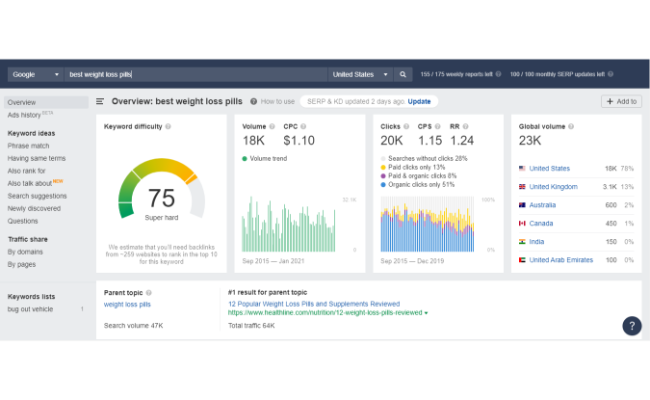
If we continue with the weight loss example and try “best weight loss pills” in the United States, we see a ton of search volume, and it’s super competitive.
It would be tough to rank organically for this keyword, and the CPC is $1.10, which is high.
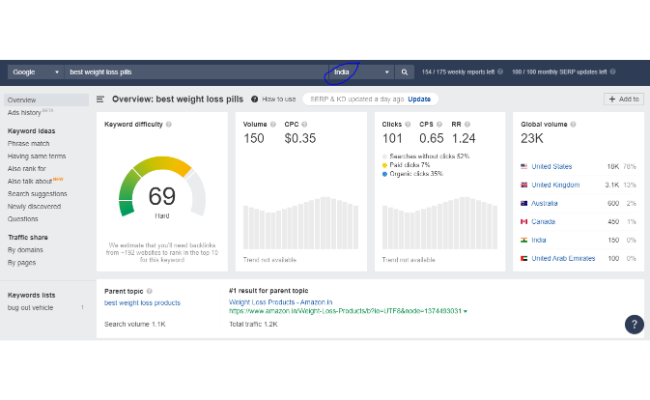
When we switch the audience to India, the search volume drops dramatically to 150 and a CPC of $0.35. We may not want to advertise this keyword to this audience, but if we do, we don’t need to budget as much as in the United States.
4. Advertise Where the Locals Are
You’ll want to understand how different countries use search engines and other platforms. Targeting Google will ensure you cover most of the world and exclude as few people as possible, but what about when you narrow down to a more specific audience?
There might be a high concentration of people using a different search engine in that country, and now your CPC has gone way up because you didn’t do your research.
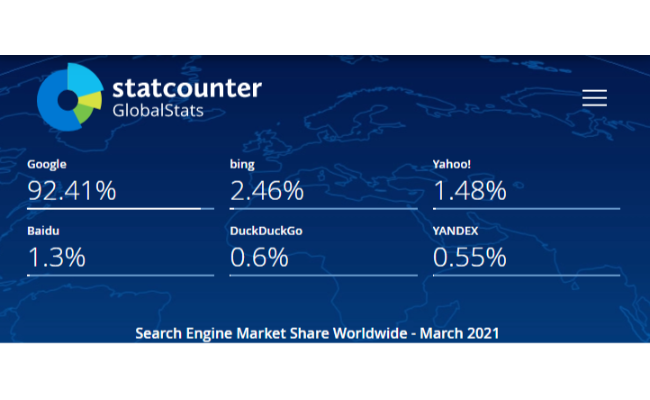
As expected, Google carries the entire planet with a 92.41 percent market share of worldwide internet usage. If you’re starting a campaign and want to see which countries respond best, advertising on Google sounds like the right way to go.
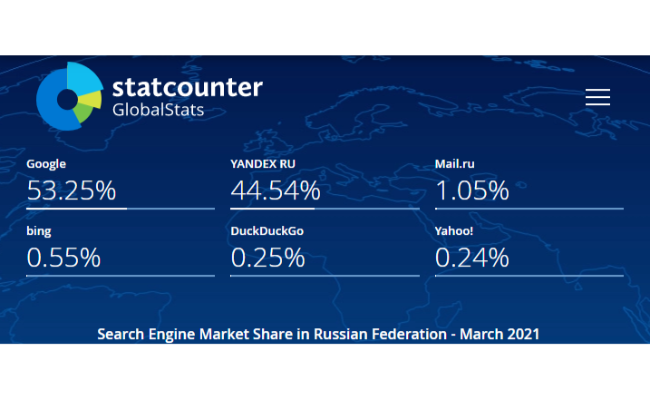
Look what happens when we narrow it down to Russia: 44.54 percent of users use Yandex. In this case, advertising on Google would exclude nearly half of the people in the country because they wouldn’t see your ad.
Google provides many resources to help advertisers, and statcounter.com is a great way to get data about foreign, unfamiliar countries.
5. Organize and Keep Tabs on Your Campaigns
The organization is an overlooked but crucial aspect of managing international PPC ads. It’s even more important because if you’re not keeping individual tabs on each country, you’ll have a harder time determining which ads are converting—and which aren’t.
If you aren’t careful, countries with low CPCs and high volume will use all of your ad spend even though they’ll never convert. While this is happening, countries that might have a higher CPC, but also higher conversion rates could be left behind.
So make sure you have a robust tracking program in place before you launch.
You’ll also want to track varying time zones. If you put two countries on opposite sides of the globe into the same campaign, you’ll need to keep in mind that raising or lowering the bids during certain times will do the same for the country on the other side of the planet.
A better choice is to separate campaigns by country and stay on top of your stats more than usual.
6. Take Advantage of Localized Concerns
Another reason to keep each campaign unique to a region is that you shouldn’t use the same ad copy across the board. Even when you start with a broad ad, you’ll still want to keep the message exclusive to a certain region and change the copy as you transition from one region to another.
The same ad copy rules apply no matter where your target audience is. Identify pain points people in that region may have, things that excite them, and what causes them to buy. These factors will vary from region to region, however.
For example, seasonal trends will vary from place to place. Google Trends is a great way to identify this.
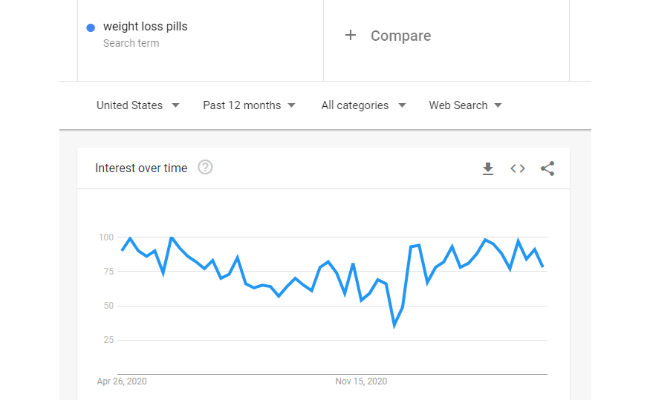
Suppose we use the example of weight loss pills. The trend has generally been consistent for the past 12 months, with a slight dip during the winter months.
This tells us that Spring would be the best time to advertise something like this because more people are likely thinking about losing weight as Summer approaches.
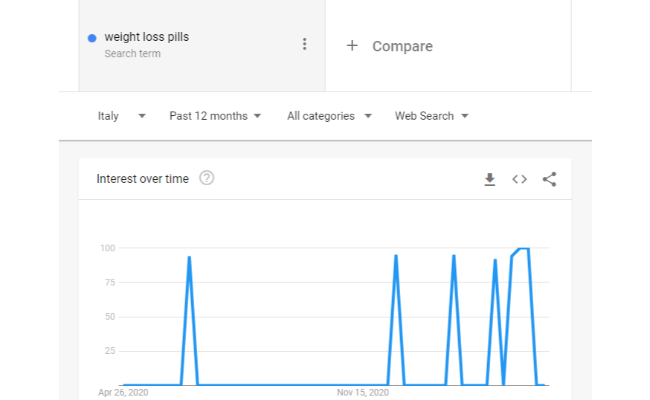
Research the same term in Italy, and the interest is almost non-existent for months at a time. The culture in the country may not recognize weight loss pills as a method of losing weight, or they may simply not have as much interest in weight loss as in the United States.
The point is, your ad copy needs to address the concerns of the specific region or country. You don’t want to serve the same ad to every area because they may not relate to it or have an interest in the topic.
7. Use a Local Domain Extension
Credibility and trust are important factors for any campaign, but it is doubly essential for international PPC ads. Use a domain extension to match the country you’re advertising in to build trust fast—which is crucial when you only have a few seconds before someone bounces.
While having a “.au” or “.co.uk” domain extension might not seem like a significant change, it can make a massive difference in the long run. Plus, think about the advantage it might give you over someone using a standard “.com” or “.org” extension.
Having a domain extension to match the country gives you the local appearance and increases the chances of someone clicking on your link. If you think about it like this, we have certain trust signals in the US as well. It’s like the endless battle between choosing “.com” or “.org.”
The same trust signals apply all over the world, and every little bit helps. ICANN.org provides a long list of domain extensions based on specific countries.
Conclusion
When it comes to international PPC ads, you can’t cut corners or take shortcuts and expect to have success. Keep your campaigns organized by country, keep tabs on your ROAS (return on ad spend), and be sure to factor in little details like time zones and domain extensions.
The good news is, there are plenty of marketing resources to help make your worldwide dream a reality.
What countries are you targeting with ad campaigns? Let me know in the comments.
via https://AiUpNow.com April 27, 2021 at 09:00AM by Neil Patel, Khareem Sudlow,
